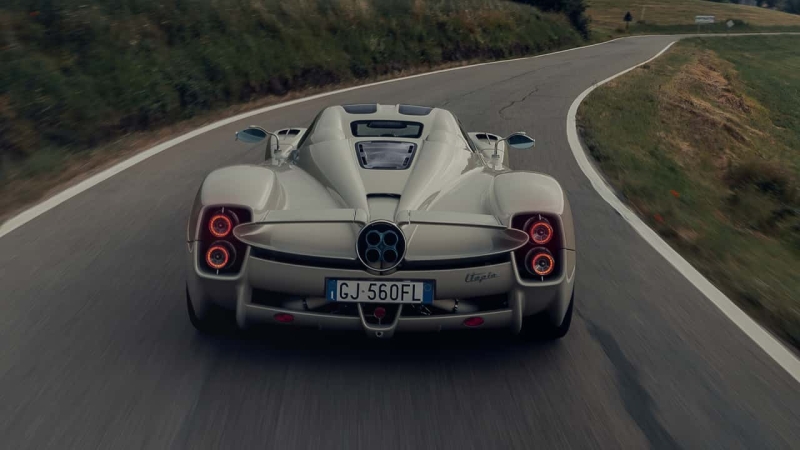In a world rife with hypercars, nothing compares to the Pagani Utopia. It’s a zenith of design, attention to detail, and outright passion. While it won’t win the numbers game, it doesn’t have to. This is Pagani’s masterpiece.
Sevian Daupi / Motor1
I shouldn’t speak of any car in terms like these. It’s only a rolling object, after all. Carbon and steel, rubber and leather. And yet, there’s not a single piece of the Pagani Utopia that begs for less than hyperbole.
This is the best, most-soulful, most-immaculate, beautiful, and inspiring car built in the last decade. Nothing comes close. A visit to Pagani’s ever-expanding HQ left me slack-jawed at the company’s capability and the passion of its staff, but mostly at its ambition.
Not even NASA compares anymore. How’s that for hyperbole?
As proof, this hypercar pronounced ooh-toe-pia poises against an Italian hillside like a coiled snake. Its driver’s door swings up and out, opening like a gilt-stamped invitation. One foot probes deep in the footwell formed by Utopia’s carbon monocoque. You lump into the seat, slowly at first, then all at once, like falling in love.
Then you’re right there, front row at the jeweler’s counter.
The Utopia’s interior is made of whimsy, all milled metal switches and gossamer. The center stack sits upright, two lightly polished panels clutching rows of gorgeous gauges. Each component was designed and produced with unthinkable care by Pagani’s 180 staff.
They pack so much detail into every interior component—subtle surfacing, bespoke typefaces, knife-edged millwork—it’s impossible to take it all in. Anything from an HVAC switch to an indicator stalk could explain so much about this car and the people who build it.
But I’ll tell you about my favorite bit.
Utopia’s steering wheel starts life as a single block of aluminum. It weighs about 80 pounds. CNC mills pare excess from the slab, pass after pass. In time, the crude form begets something refined, something beautiful. A special six-axis mill then takes the reins. It’s one of only a handful on earth. The mill hollows the wheel’s spokes and rim, scooping out interior curves like you would a pumpkin.
Thin aluminum covers hide the hollowed-out portions, leaving only a neat row of hex bolts to hint at the recess beneath. The tolerances between wheel and covers are machined so precisely that your fingernail can’t tell where one surface ends and the other begins—a human hair couldn’t squeeze through the seam, even if it sucked in its gut.
The wheel’s aluminum surface requires eight further hours of hand finishing to achieve the perfect satin sheen. No machine can match human skill here, Pagani says. Then it’s off to the production floor where one worker swaddles the wheel in immaculate leather and stitches it all up by hand.
Every last one of the Utopia’s 32,000 new components—there’s almost no parts sharing with the outgoing Huayra—was treated with such reverence. Whether milled from billets or baked in an autoclave, everything’s fettled endlessly. It adds up to 640 hours of complex milling per car, piled on the countless hours spent designing each part, prototyping the part, creating tooling paths to machine the part—and in many cases—starting from scratch when founder Horacio Pagani walks into the room and demands perfection. Again.
When you glimpse the effort up close, whether from Pagani’s production floor or from behind the Utopia’s gorgeous steering wheel, it clicks. The cumulative effort poured into this car is staggering. Where any other hypercar maker would reach for an off-the-shelf part, Pagani designs and builds from scratch, in-house. I simply don’t know how Pagani turns a profit on the (roughly) $2.5-million Utopia.
Blissfully, it’s even better to drive.
A ruby red “START” button lives at the base of Utopia’s gorgeous center stack. A single press lights the 60-degree 5980-cc twin-turbo V-12 in a throaty trill. If you’re standing behind the car for the start procedure, it’s hard to tell if the car just orgasmed. Or if you did.
The Utopia’s clutch pedal proved daunting to calibrate, Pagani’s test driver Andrea Palma informs me. To corral 864 horsepower and 811 pound-feet, the drivetrain was built from sturdy stuff: multi-plate clutches, inch-thick exotic alloys, and brimstone. With drivetrains, that mechanical heft generally translates to physical heft.
Not here. Master cylinders and clutch discs shuffled in and out like seasons, Palma says, until Pagani found the perfect solution. The Utopia pulls away from a stop like a feather on a breeze. No drama, no judders. Just aim the nearly 900-horse rocket at an Italian mountain and go. Even better if the mountain road is a great one.
This one’s great in the way wooden roller coasters are—huge thrills but mostly the kind of shaky terror that drains the blood from your lips. This rough thin asphalt ribbon lives just outside Modena, coiling against the hillside over and over as it rolls from one computer-background vista to the next.
Utopia eats up every inch of the lumpy surface, even if its hypercar proportions—long, low, ultra-wide—seem to stretch from the road’s ragged edge to well past its centerline. Every bodily hole clenches like a vice when, inevitably, each hairpin apex hides a careening hatchback on the other side.
Still. For a car this capable on a road this tight and bumpy, it’s amazing how easily the Utopia goes. Rising up to the V-12’s 6,500-rpm redline, the Utopia’s 325-section rear rubber kicks sideways out of every slow damp sweeper. Same goes for third-to-fourth shifts on straightaways. Your right foot is merely a conduit to vaporized rubber.
So much power. So much torque.
This Mercedes-AMG mill is an absolute unit, a mile-wide bonfire of sound. There’s none of that “tearing-silk” Italian nonsense here, just a progressive shouting snarl up through every gear, the cabin awash in turbo shwoossshhhh and the soundtrack of two hungry beasts squaring off in the Serengeti.
Sounds friendly, right?
It actually is. There’s a progressive quality to Utopia’s handling, especially while the V-12 vaporizes those rear Pirellis. Within a few corners you’re anticipating the slides, reveling in them. The front end feels tacked to the earth, offering cautious light push when grip runs dry. The chassis remains stable whenever you lift throttle, never threatening to swing around and pirouette that V-12 into an onrushing Fiat.
The Pagani’s ample damping, courtesy of electronically controlled shocks, includes a comfort mode that pares down pothole thwacks but never removes a sense of connection to the road. Pagani staff encouraged me to switch over to comfort mode repeatedly, but there’s not much need for it.
While the Utopia doesn’t magic-carpet over the road like a McLaren 750S, it feels lithe and active whatever the drive mode. Always comfy, never dull. Likewise, Utopia’s steering is calibrated for all-day driving, lighter on- and off-center than other cars chasing the Pagani’s high-Test coattails.
Maybe it’s the Utopia’s 2,822-pound dry weight that makes the car feel effortless?
While working Utopia up to speed, even the spectacular engine and chassis play second fiddle to Pagani’s headlining act. Yes, the stick is back. After a Huayra hiatus, Xtrac provides a seven-speed ‘box mounted transversely beneath the Utopia’s hindquarters. It’s actuated via cable, controlled by that big gorgeous shift knob rising between the Pagani’s driver and passenger seats.
It’s a dogleg ‘box, so first gear sits down and to the left. This layout calls back to classical racing cars, sure, but it’s also a concession to the seven-speed pattern itself. There’s a chunky, rubbery resistance to complete each shift and a pair of pronounced detents between the gates.
Because of the seven-speed shift pattern, detents center the shift lever in two separate positions, one on either side of the third-forth interchange, leading to some cautious moments when you’d rather focus on tucking the Pagani’s nose toward an apex.
“Is that fourth gear?” you wonder, slotting the shifter over and up a notch from cruising speeds. “Or am I about to set off a multi-million, second-gear grenade?”
Utopia owners will commit the pattern to muscle memory, in time, but it’s not telepathic like the greatest manual transmissions seem to be. Especially in hard heel-toe downshifts to second gear, when a heavy resistance against the shift lever makes you wonder if second is fully selected.
Still, I’m thrilled to have the stick back. So are Utopia customers. According to Pagani, 70 percent of the first 100 Utopia were specced with a manual. The alternative is an automated version of the same Xtrac gearbox. We wish those owners peace of mind. Even if they’ve chosen incorrectly.
After an afternoon blasting down and up the mountainside, Palma raises an eyebrow. He asks if I want to drive the Utopia back to Pagani HQ. The question sounds more like a provocation. I hand the keys (metaphorical keys, of course; The real “key” is a little ingot shaped like a Utopia, milled in-house, because of course it is) back to a development driver who’s covered hundreds of thousands of kilometers in this very car.
Palma lays down a circus show on the road, loading the Utopia’s snout against the car’s front six-piston carbon-ceramic Brembos, then hanging the Utopia’s tail WAYYYYY out in every corner, letting the engine wail and moan down every inch-long Italian straightaway.
As a car writer, it’s your sworn duty to play stoic from the right seat, no matter who or what’s happening behind the wheel. Instead, it takes minutes for the stream-of-consciousness chatter to stop flowing from my mouth into the Utopia’s immaculate interior. If modern performance figures have you thinking the Utopia comes up short on the stats sheet, try to keep up with a Palma-driven Utopia on a back road in any other car. You’ll die trying.
Back at Pagani HQ the staff have called it a day. We roll through the front gates and bid Andrea farewell. For a moment, it’s just me and the Utopia, parked on the factory’s neatly aligned pavé.
“What a machine,” I mutter, patting the Utopia’s a-pillar like some million-dollar Labrador.
Objects like the Utopia usually have imperfections that allude to their handmade nature. Except nothing about this car’s construction is imperfect. That is the expression of Horacio Pagani’s nature. There is a precision and intentionality to everything Pagani Automobili does, from the cleanliness of its factory floor to the perfect brushed finish on that steering wheel.
Utopia is the stuff of dreams, borne of craftsmen and -women who dedicate their very souls to their work. Anyone on from the janitor to the assembly floor could speak for hours about the things they make, and with great pride. If that sounds like regurgitated ad copy, it is not. Horacio Pagani and the people who make up his company have my admiration with absolute sincerity.
As a rare journalist who’s driven an example of each Pagani model—Zonda, Huayra, Utopia—I feel a pressing need to answer one question from the commentariat: “Does the Utopia reach the Zonda’s dizzying heights?” Well, it comes damned close, which is not damnation by faint praise. Instead it’s an exaltation.
The Utopia is an even better expression of Horacio Pagani’s ideals than the Zonda, a belief that art and science should meld into a vehicle that stirs something deeply human inside us. Twenty-five years on from that first Zonda, Automobili Pagani itself has grown in capability and sophistication, but never lost sight of its values.
Is the Utopia the last word in performance? Is it simply an engineering codpiece? It is art? Is it obsession manifest? No, the Utopia is something entirely different. Something ultimately special.
It is a Pagani.
Sevian Daupi / Motor1 Get the best news, reviews, columns, and more delivered straight to your inbox, daily. Sign up For more information, read our
Privacy Policy and Terms of Use.
Pagani Utopia
Engine Twin-Turbo 6.0-Liter V-12
Output 864 Horsepower / 811 Pound-Feet
Transmission Seven-Speed Manual
Drive Type Rear-Wheel Drive
Speed 0-62 MPH 3.1 Seconds (est.)
Maximum speed 217 Miles Per Hour
Seating Capacity 2
Weight 2,822 Pounds (Dry)
Base Price $2.5 Million



